Caring for Wildlife – how it all began
We are wildlife carers for the last 30 years. We are looking after orphaned and injured animals and raise them to be released back into the wild. We mainly care for Gliders (Sugar Glider, Squirrel Glider, Yellow Bellied Glider, Greater Glider, Feather Tail Glider and also Ring Tail and Brush Tail Possums). And, for the last three seasons, we are also a release station for Fruit Bats.
We know that Fruit Bats often make people uneasy or even aggressive towards them. However, Fruit Bats are the most important nocturnal pollinators in Australia, which many farmers have recognised and found ways to protect their fruit crop without harming the animals.
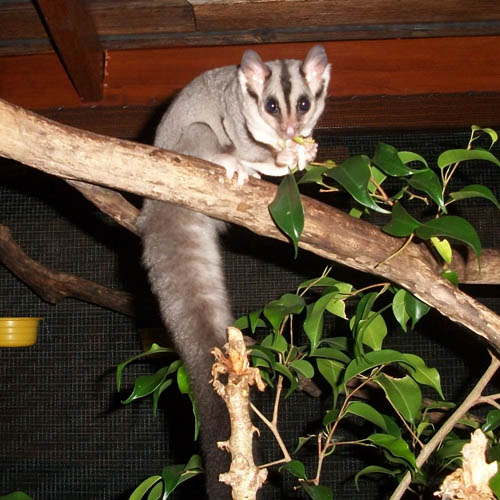
Squirrel glider munching on a grasshopper
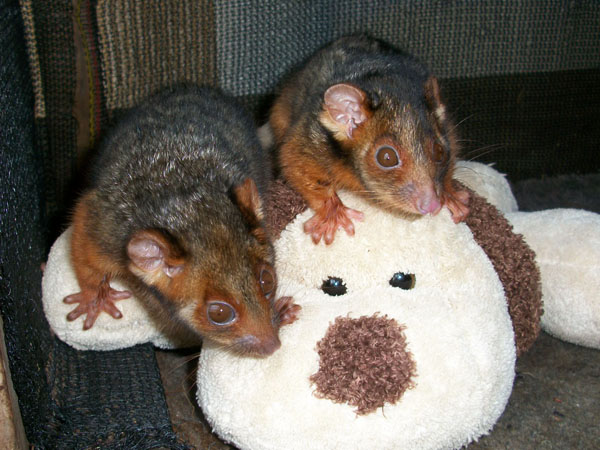
Two baby ringtail possums holding tight on a fake mum.
Arriving in Australia from Berlin some 33 years ago we soon became
interested in the Australian wildlife. The local ranger told us that it
was difficult for him to find foster carers for injured animals. So,
because of our love for animals we started taking them in after acquiring
the permits to care for wildlife.
We are lucky to live on a
reasonably large property with natural bushland and forests which allow to
soft release the animals. This means that we do not release the animals
somewhere, set them free and hope they will be alright and survive.
If
a colony of gliders is ready to be released we ‘soft’ release them by
making a little opening in the wall of a release house to give the animals
the chance to venture outside, get used to the new environment, but still
be able to come back “home” untill they eventually decide to stay out for
good.
We have therefore built several release houses which are all
up to 5 metres in height. Inside, these houses replicate the outside bush
so the animals can learn or learn again to jump, glide, run, hide, climb,
fly and find food - prerequisites for the survival in the wild.
The
impact human society has on other living beings made us realise how
important it is to preserve what we have got to counteract purposefully or
unintentionally killings of other sentient beings.
If we want to
live in a world not sterile and empty of animals (and plants for that
matter), a totally new and different thinking and behaviour towards our
environment seems to be necessary. In so far everyone of us needs to be a
conservationist to protect the biodiversity of our planet. Each species
that goes away means one less link in the ecological chain, minimally
increasing environmental instability with disastrous consequences in the
long term.
To accommodate Animals for rehabilitation
When we started to accommodate and care for
wildlife we soon found that it is not enough to have an injured animal
treated by a Vet, put in a cage, feed it and release it once the injury
has healed.
An animal having had a traumatic
experience (being caught in barbed wire, brought in by a cat or dog, being
made homeless because a tree it lived in was felled or knocked over by the
wind etc) often needs quite some time to recover. This is when another
problem appears:
The general rule is that it is best to release a
recovered animal where it was found. This is because the animal is used to
the territory, others accept it there and if the animal usually lives in a
colony it is welcomed in again. However, if to much time has passed
(around two weeks) the animal’s scent has faded and it is not recognised
anymore. Fights break out and the looser is the released animal. It gets
killed by its own colony or driven out of its former territory. This might
very well be happening too, if rescued animals are being released
somewhere in the bush foreign to them.
Following this line of
thought it became obvious to us that, while a recovering animal needs to
be in a save environment, it should at the same time have contact - though
limited - to the outside world.
To achieve this the concept of
‘soft release’ from purpose build release houses was developed. The inside
of these houses should be designed to replicate the natural bush as
closely as possible, while save contact to the outside world should be
possible through the material the houses are enclosed with.
The Building Process
Planning of
the new release houses has been like any other project. However, we found
out quite quickly that it was impossible for us to finance the three
houses in one go, because we are retired and only on a small pension. So,
we started with number one.
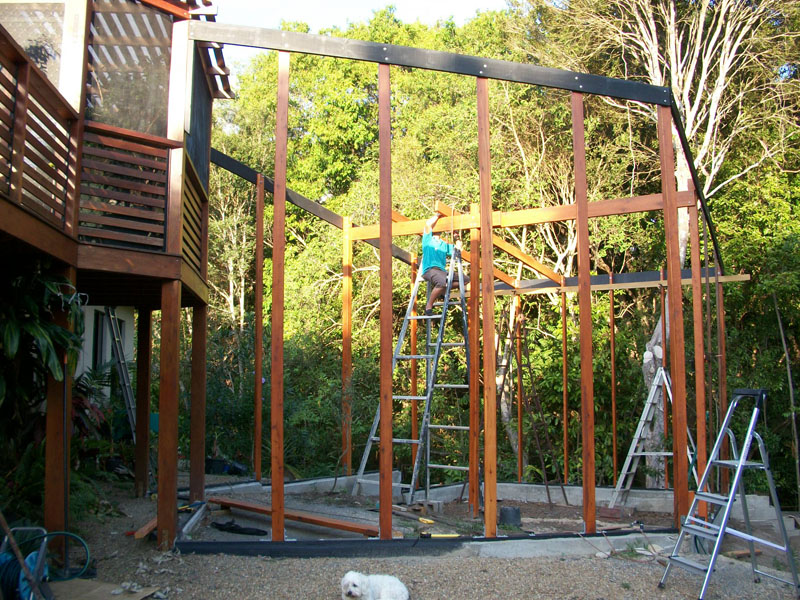
The picture shows how we started to built the first of our new glider
enclosures which is connected to the deck of our house. Manfred is sitting
on a tressel to fix one of the top beams. The picture shows also that this
structure is two storeys high, which gives native trees enough room to
grow in it.
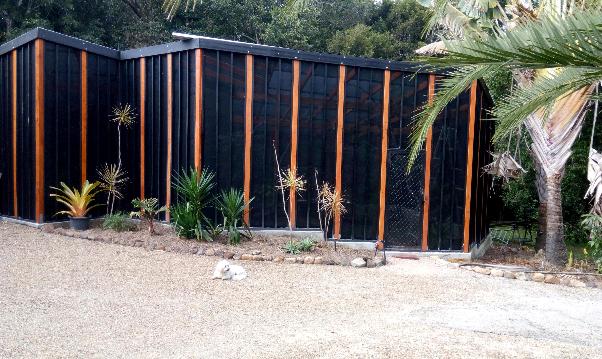
The picture shows the finished result of the first of the new enclosures.
At the back of the house runs a creek with a steep bank which
tapers about three metres down. So the footings of the structure had to be
build up for more than a metre to be level. The footings also serve as a
‘rat wall’, so they stop rats and mice from digging channels to get
inside. This is important, because those channels would be gateways for
snakes to get inside for easy pray on the injured animals. The walls and
the ceilings of all the structures are closed with shade cloth. This is a
very strong material but flexible enough not to hurt the paws of the
animals when they run up and down the shade cloth walls. However, since
shade cloth is no match for rats, especially the native rats (Melomys sp),
we used a dense mesh, called Snake and Mouse Wire, as an outside layer.
This first new glider
enclosure is attached to the deck of our house via a stair case so we can
access it from the house and from the outside.
We started building this
enclosure in August 2013 and finished in June 2014.
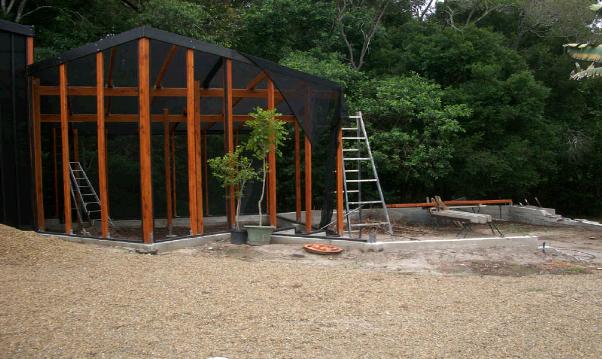
The second glider enclosure in the making. You can see the
foundation or "ratwall" which is about 300mm in ground to keep rats
from getting into the houses.
The last of the
three Glider Houses was finished in March 2017. So after nearly 4 years of
labour and $29,000.00 spend on building materials, we were able to
accommodate several colonies of sugar gliders, Yellow Bellied and Greater
Gliders, Feather Tail Gliders and also up to 40 Flying Foxes until they
are ready for release.
